This is a Veteran Owned site

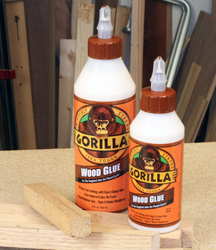 |
 |
It was not a big surprise to hear the the Gorilla Glue folks had come up with their own wood glue. Besides the price and performance of this new wood glue the fact that it is Made in America makes it even more attractive! |
|
Gorilla® Wood Glue
Strong, quick and American Made
Text, photos and video by Tom Hintz
Posted – 9-27-2011
I had the opportunity to try out the original Gorilla (polyurethane) Glue several years ago and have used it myself ever since. I liked the relatively long open time for applying it to complicated joints like dovetails and the near bulletproof strength when cured. Now those same people have taken a fresh look at the regular woodworking glues we use and they came up with Gorilla® Wood Glue. Not surprisingly this new type of woodworking glue is tough and easy to work with. And, it is Made in America!
The Basics
Gorilla® Wood Glue is a cross-linked polyvinyl acetate (PVA) that has been designed to produce higher than normal bond strength with a shorter clamp time. You do have to let Gorilla® Wood Glue dry overnight for the maximum bond but in most cases you can remove the clamps in just 20-minutes and it develops roughly 80% of its total bond strength in just 1 to 2 hours! That means you can move projects along more quickly without weakening the glue joints. Gorilla also found a way to lower the minimum ambient temperature that is necessary to achieve a good bond to 50-degrees. The Gorilla folks haven’t visited my shop ever and certainly not during the winter months but it sure seems like they have been watching or something! The performance of the Gorilla® Wood Glue has been very good throughout my testing but more on that a bit later in this review.
Spreading it Thin
One thing that isn’t new with the Gorilla® Wood Glue is the need to apply it in a thin coat evenly on both surfaces being joined. As with any glue, you need good fitting joints and clamps applied with enough pressure to keep the pieces pressed together. I have done that for you and we will look at that later in this review and on the accompanying video.
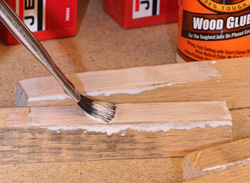 |
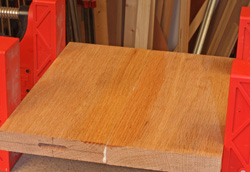 |
I over did the glue a little (left) so we could try the main glue cleanup techniques here also. Once the parts were glues they went into the clamps for only 20-miuntes (right) and then removed and set aside to cure for 24 hours as per the instructions. Click images to enlarge |
|
The 5 to 10 minute open working time of Gorilla® Wood Glue seems about right for a bunch of woodworkers and myself, even when I am gluing up dovetails. If you can’t get a portion of the project assembled in 10 minutes you need to come up with a different plan. Most of us dramatically underestimate how long ten minutes really is anyway.
I “accidentally” applied a bit too much Gorilla® Wood Glue when doing our test glue ups. I used a damp paper towel to clean up one side of the board glue up but let the squeeze out dry on the other side. Later I will try scraping it off so we can see how Gorilla® Wood Glue responds to these very common techniques. I generally favor the scraping technique with this type of glue but either way seems to work just fine with Gorilla® Wood Glue depending on the situation.
Gorilla® Wood Glue dries to a neutral tan color that blends well with most wood grains. It is sandable and paintable so you can use it for just about any job in the shop or around the home that involves gluing wood to wood. Gorilla® Wood Glue is not meant for gluing other stuff to wood. Their polyurethane-based Gorilla Glue can handle those miss match situations.
Gorilla® Wood Glue is classified as and has passed the tests for the ASNI/HPVA Type II glues. That is the industry standard test to earn the “water resistant” label. This Gorilla® Wood Glue can be used on indoor and outdoor projects as long as they are not submerged in water. If you need to glue something that will live under water you need their original Gorilla Glue, the polyurethane version again.
Other important points for woodworkers to consider are that Gorilla® Wood Glue doesn’t expand as it dries. It also complies with FDA (Food and Drug Administration) standards for indirect contact with food. That means that it is non-toxic and does not emit hazardous fumes while drying or when dry. Gorilla® Wood Glue is also mildew resistant which is more important than many of us think about.
In the Shop
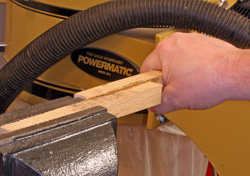 |
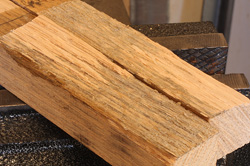 |
24 hours later I secured the stick glue up in my heavy vise and pulled on it until it failed. Incidentally it took way more force than I was anticipating to break this and I nearly punched myself in the face when it let go! On the right is the glued faces that failed. You can clearly see woo that has pulled out of the opposite side indicating that the wood failed, not the Gorilla® Wood Glue |
|
I know that testing glue on camera is difficult on a good day but I’ll give it a shot anyway. I cut some pieces from a length of roughly 1”-square red oak scrap. I wanted these pieces long enough to glue a 3 or 4”-long section together but have “legs” long enough to secure one in a sturdy vice and have enough room on the other leg to pull on it until failure.
I applied a film of glue to both sides of the joints (made two assemblies) and then placed them in a pair of clamps. I now the clamps look way too big for this and they actually are but wanted to apply even pressure across the joint are of both pieces I made. I applied just a little hand cranking pressure and let the assemblies sit for 20 minutes. Then the pieces were removed from the clamps and set aside to dry for the 24 hours recommended in the instructions. Tick, tick.
I also edge glued a pair of red oak boards, roughly ¾”-thick that I had milled up in my shop. They had straight edges so I brushed on a film of glue on an edge of each piece and placed them in clamps for 20 minutes. I had over done the glue a little on purpose so that I could try both common cures for squeeze out. During assembly and clamping I developed a bit of a run so did that cleanup immediately with a damp paper towel. I left whatever squeeze out was happening on the bottom side of the joint for after it had dried. Then I will scrape the excess glue off and sand the joint. I then removed the glue-up from the clamps and set it aside to cure for 24 hours.
Breaking Up
I clamped one leg of the first two glue ups in my heavy machinist vise and pulled for all I was worth. I expected a 1”-square piece of oak to fail somewhere with far less force than I eventually had to apply. Finally it did snap roughly along the glue line and with the amount of force I was applying I nearly punched myself in the face when it did fail!
Looking at the separated sections it is clear that the wood around the glue failed, not the glue. The presence of wood fiber and rather large chunks on both sides of the joint is clear evidence that the wood gave up before the glue. I tried the same test on the other stick glue up with very similar results. This time there was no large chunk of wood pulled out but the entire glued surface on either side had wood fiber all over it indicating that once again the wood gave up first. With modern glues that really is the expected result and the Gorilla® Wood Glue definitely falls into that category.
Video Tour |
Next I scraped the excess glue from the edge-glued piece and then sanded it with my ROS for less than 1 minute. The nearly invisible glue line demonstrates how the cured color of the Gorilla® Wood Glue blends in with most woods that we work with. Keep in mind that the pictured joint is rough sanded only and there is no finish applied that will certainly conceal the joint line even more.
Conclusions
Gorilla® Wood Glue has all of the characteristics woodworkers like in an adhesive. It applies easily, sets up fast, cures fast and holds fast as well. The color is right to make well-prepared joints disappear when finish is applied. On top of that being non-toxic and water resistant make Gorilla® Wood Glue useful in a huge range of projects common to woodworking.
Gorilla® Wood Glue is carrying a street price of just $2.98 (9-27-2011) for the 8-oz bottle and $6.99 (9-27-2011) for the 18-oz bottle. That puts Gorilla® Wood Glue in line with other glues in this class. That makes my decision on which glue to buy simple. I like how the Gorilla® Wood Glue works in the shop during assembly and the resulting strength once it has cured. Sanding Gorilla® Wood Glue is also very easy and requires no special techniques which when combined with the price makes this an even better value.
Visit the Gorilla® Wood Glue web site – Click Here
Have a comment on this review? –Email Me!
All written, photographic and drawn materials are property of and copyright by NewWoodworker.com LLC 2000-2019. Materials may not be used in any way without the written permission of the owner.
